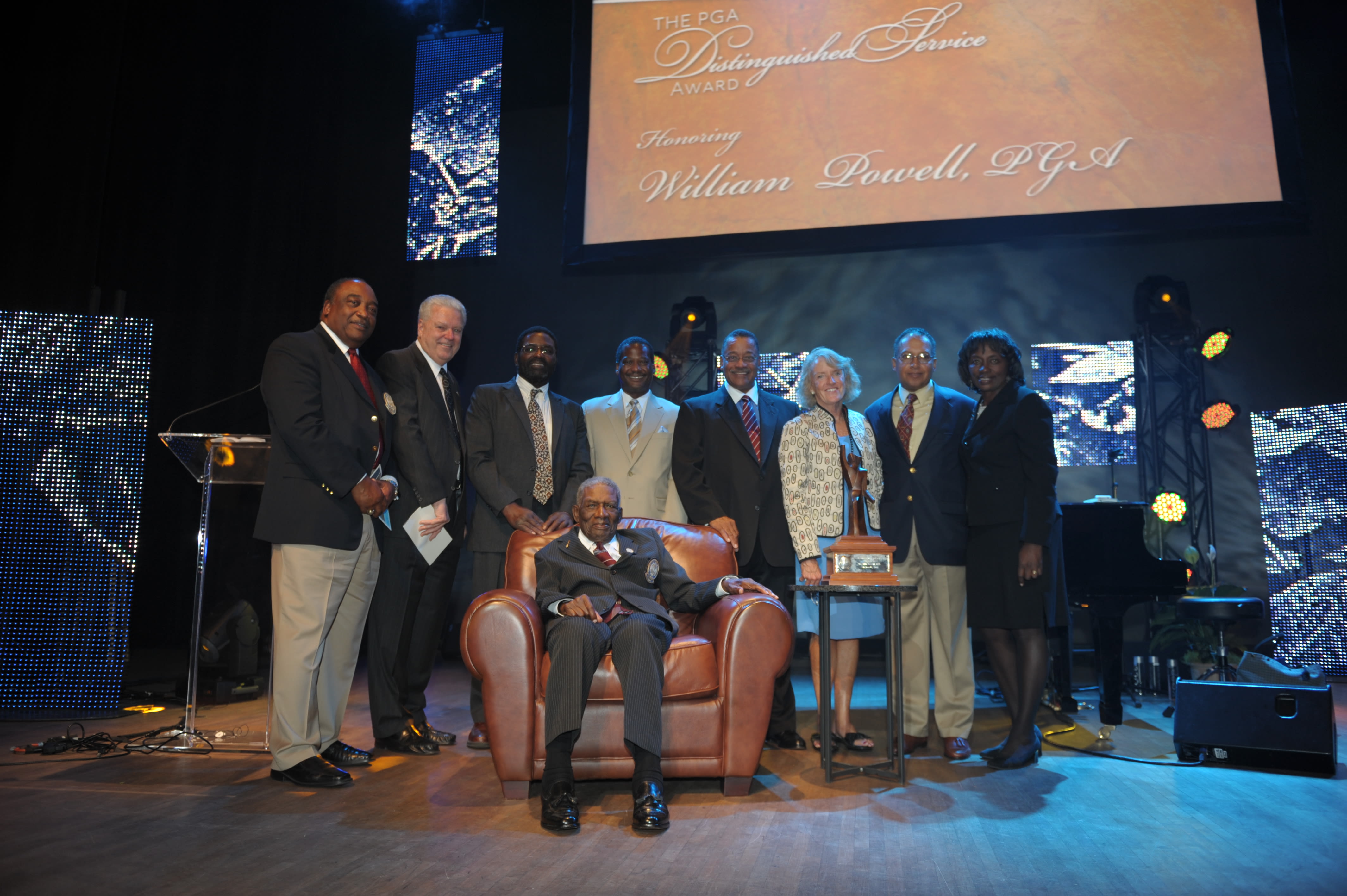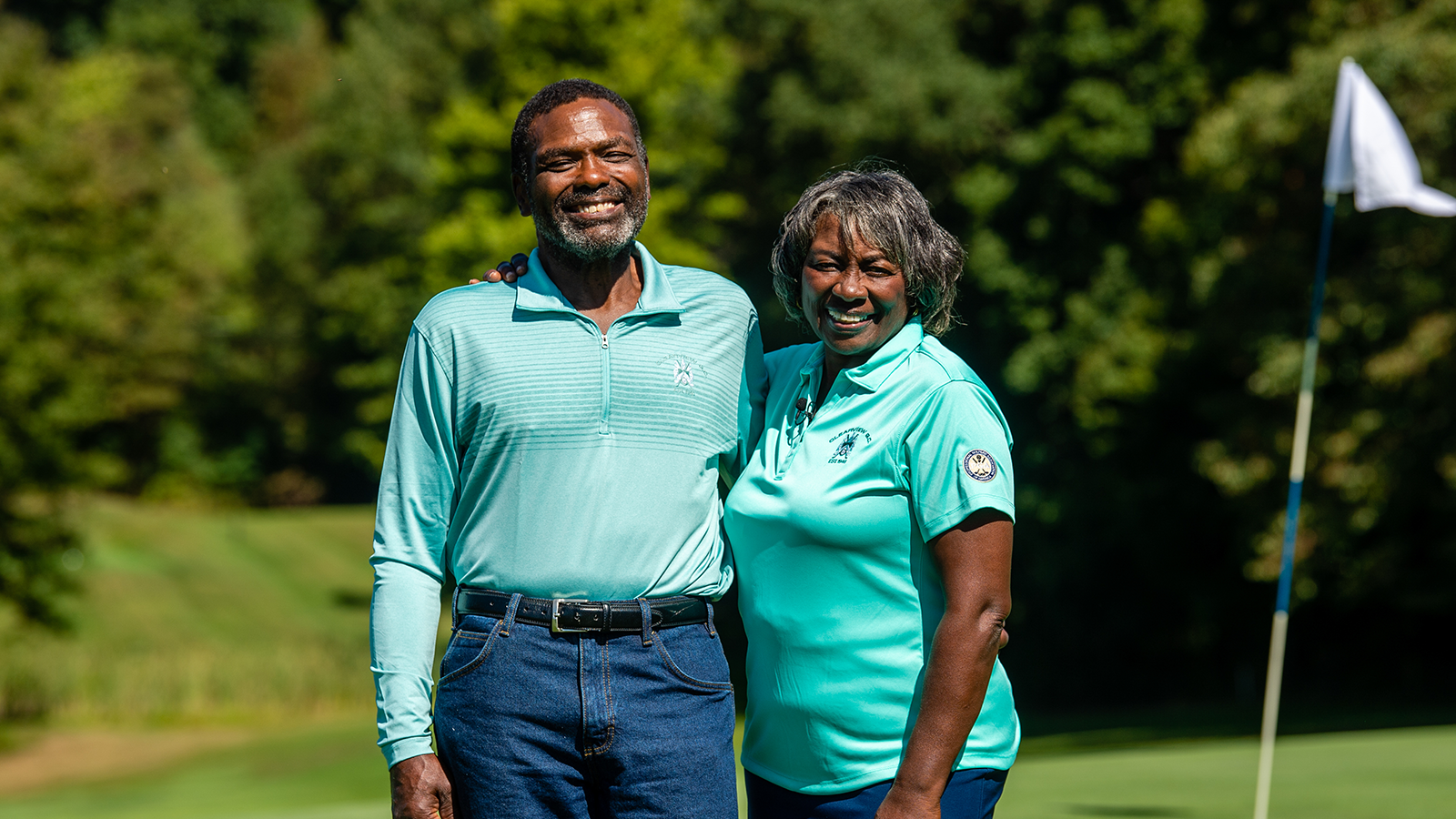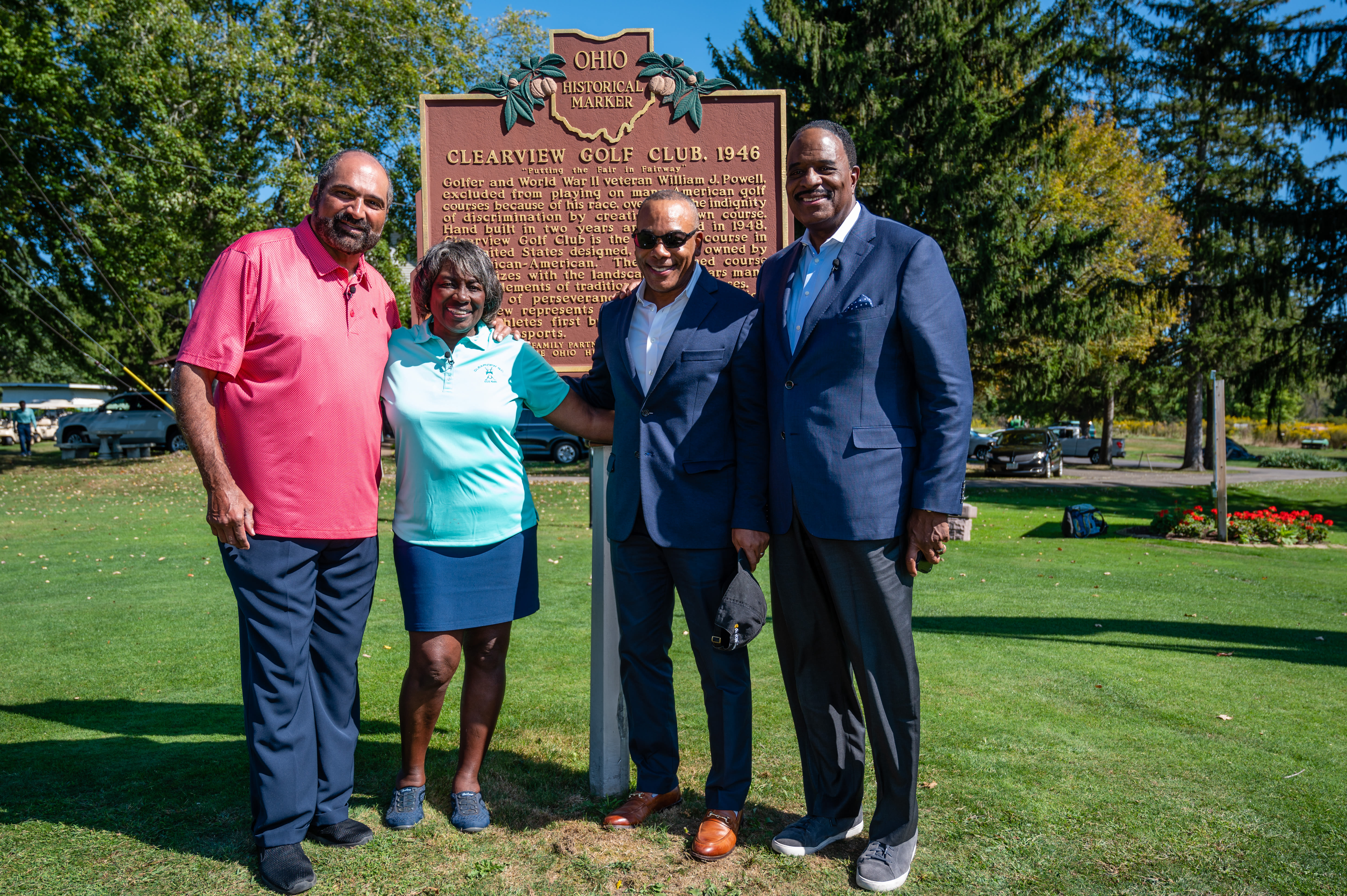Game Changers
Clearview Golf Club Defied the odds; 75 Years Later, the Campaign Stirs to Preserve a Legacy
By Bob Denney, PGA Historian Emeritus
Published on
Video presented by AIG Life & Retirement
Clearview Golf Club of East Canton, Ohio, where the late William James “Bill” Powell carved a gem of a public course out of a dilapidated dairy farm, celebrates its 75th anniversary this year.
The only golf course in America designed, built, owned and operated by a Black man earned a berth in 2001 on the National Register of Historic Places.
Seventy-five years ago, “Mr. P,” as he was affectionately called—or “Dr. P,” after receiving an honorary doctorate from Baldwin-Wallace College in 1998—defied monumental odds.

“You look at the sacrifice and what it took to achieve us getting here,” said his youngest son, Larry Powell, a 50-year member of the Golf Course Superintendents Association of America. “Attention to detail -- it was how I was raised.
“My mother, Marcella, would always say as she pulled out the books, ‘I am not rounding any figure, I’m balancing it to the penny.’ It was a major key to our survival. . .and a faith in God.”
The genesis of Clearview began when Bill Powell returned from serving his country in World War II only to be denied the opportunity to play golf in his homeland. It didn’t matter that he could play any public course in the United Kingdom, where he was treated with respect. Back home in Ohio, Powell was an outcast.
When Powell got the tip from white military buddies that he could get the funds to build his own course, he was stopped cold. Journeying from one bank to the other in his area, officials looked at him and lied in unison: “G.I. Loan? Huh? You must be mistaken.”
“To build a course from a plot of land with no money was a miracle in itself,” said Renee Powell, Bill’s only daughter, the PGA Head Professional at Clearview since 1994 and the second Black woman to compete on the LPGA Tour.
“My dad taught two local doctors how to play -- one of which delivered all of us children -- and then he told them his goals. They ended up agreeing to each put in a third to raise the funds. My dad, who had no money, convinced his brother in Los Angeles to mortgage his house to help get that needed third.”
Her father worked 29 years at The Timken Company bearings plant, primarily on the 3 to 11 p.m. shift.
“Then, daddy was determined to go forward and dealt with the cynicism and racism of his own country -- from a mental and physical standpoint, it was a huge challenge. I don't think anyone in their right mind would go out and put that physical abuse on their body and build a golf course. You don’t see one person building a course today, do you?”
Powell would come home, get a few hours sleep and rise to work the land before returning back to Timken. He worked 18 hours a day.
With limited equipment in 1946, Powell began clearing the land of fence posts and rocks before sowing the seeds of what he called “Clearview.”
“I named it Clearview because of the striking clear view from the area of the old seventh tee, now No. 9,” Powell wrote in his 2000 autobiography with Ellen Susanna Nösner, Clearview: America’s Course. “There’s a clear view from most anywhere that you stand on these 130 acres.”
In the spring of 1948, he opened the first nine holes. After paying off his loans, in 1978 Clearview expanded to 18 holes.
Powell, who passed away in 2009, said he built the course to “allow anyone who wanted to play golf the opportunity to do so and feel welcome. . .and “put the fair back in fairway.”
For as long as Clearview has been open, it’s had a maintenance issue -- no automatic irrigation system. It is the top priority of the Clearview Legacy Foundation for Education, Preservation and Turfgrass Research, a 501(c)(3) tax-exempt charitable entity.
Despite a lack of irrigation, Clearview has what Renee proudly calls “some of the best greens in Ohio.” That’s the fruit of brother Larry’s turf magic. The man who first worked the course at age 8 mowing greens and has had full maintenance responsibility by 14, uses slow-release fertilizers and watches the weather, relying on the rain. He planted grasses that are more resilient in hot weather so Clearview’s greens continue to welcome golfers season after season.

Larry and Renee Powell, PGA
But years of pulling hoses in place and the wear and tear on the body has pulled at Larry, 69, who for 30 years split his day between the course and working as a Postal Service clerk.
Larry’s spouse of 32 years, Teresa Lynn Cole, passed last year to cancer. After 12 years of part-time classes from The Ohio State University, she became an assistant superintendent and horticulturist.
According to Larry, Clearview relied on other unsung team members to endure. Like his oldest brother Billy, who died in 1967, and husband and wife Walt and Pat Wilson, who split time between course maintenance and clubhouse duties and Powell’s cousin, Norman Hill.
“I spent my pre-teen and teen years working at Clearview and came away feeling it was one of the best experiences of my life,” said Hill. “Mr. Powell was a patriot, a terrific person and a tough taskmaster. He taught to be honest with yourself, not be dissuaded by problems and not get discouraged.”
Overcoming Crisis and Racism
Clearview has endured its share of crises. When Powell was building his first nine holes, there were countless instances of intimidation. Powell said hunters or those passing by the course on a joyride would take target practice at points around the course.
In 2009, there was a bid by Buckeye Industrial Mining Company of Lisbon, Ohio, to open a strip mine 370 yards away. A campaign led by State Senator Kirk Schuring was instrumental in ending the mining bid.
The intimidation continues today, said Renee. “There are people driving by who yell the ‘N-word’ and other ugly things. You can hear it when you play along the 13th fairway.”
Then, there’s subtle racism. Renee said it was commonplace that golf customers would share how they had asked for directions to the course in Canton.
“I remember a golfer paying his greens fee and he mentioned that when he asked for directions at a gas station, the guy at the station said, ‘Oh, you mean the Black Course?’ ”
But none of that ever stopped the Powells, who have received nearly every major honor the golf industry has. For example, Bill and Renee are the only father-daughter duo in the PGA of America Hall of Fame and the Ohio Golf Hall of Fame.
In Scotland, Renee is on her own level of “royalty.” She received an Honorary Doctoral Degree in 2008; became the first American to have a residence hall named in her honor and down the street was in the first class of women bestowed Honorary Members at the Royal & Ancient Golf Club.
In 1996, at the encouragement of former PGA Chief Executive Officer Jim Awtrey, Renee Powell became the first Black female PGA Member.
“I had the pleasure of meeting and becoming friends with the Powell family in the early 1990s,” said Awtrey. “What began as an education would become a 20-year family experience. I will always cherish sitting on the hill at Clearview with Dr. P experiencing this history of Clearview through his eyes.
“It’s important to celebrate the historical significance of Clearview and Dr. P’s commitment to having a clear view of golf regardless of the color on one’s skin.”
Innovation from the Beginning
Clearview’s rolling pastoral layout has been a source for innovation, welcoming players of all colors and national origin since its inception
In 1960, Bill and Marcella Powell hosted the largest junior golf tournament in Ohio, with 120 youngsters playing nine holes.
Clearview hosts women’s leagues, senior men and businesswomen leagues, and recently added a PGA Jr. League chapter. Additionally, golf lessons are held in the foster care system through Pathway Caring for Children, and golf is offered as a tool for SarahCare program for individuals suffering differing levels of Alzheimer’s Disease and dementia.

In 2011, Renee launched Clearview HOPE (Helping Our Patriots Everywhere), which remains the only year-round golf rehabilitation program for women veterans. In 2016, she hosted a men’s PGA HOPE program. Today, she hosts the only men’s and women’s HOPE programs in the Northern Ohio PGA Section.
U.S. Army Veteran Hollis Burkes, a police detective, is one of the core members of Clearview HOPE’s nearly 60-member roster. She said the course is more than a historic treasure, it’s “a new community” for veterans.
“Our golfing home, Clearview Golf Club, has introduced us not only to a historic course, but also to historic people who we have come not only to respect, but also love,” said Burkes. “Seeing a labor of love in action is so very special to me. This course exhibits that over and over. What Mr. P built, Larry and Renee maintain by their will and by the grace of God is something I cannot take for granted.”
Returning to the Roots of Civil Rights
Clearview’s 75th Anniversary is a year-long campaign for public awareness, which excites Professor Todd Allen, the Vice President for Diversity Affairs at Messiah University in Mechanicsburg, Pennsylvania.
Since 2001, Allen has been a coordinator of the “Returning to the Roots of Civil Rights” bus tour. The nine-day, 2,600-mile, 11-city tour began stopping at Clearview in 2007. After a COVID postponement and virtual tour in 2020, the bus will return to Clearview with a scaled-down group this year.
“Clearview and the Powell family are a visual representation of what the civil rights movement was all about,” said Allen, “opening up spaces and places for people to have a full sense of citizenship and humanity. Because of Dr. Powell and a place like Clearview, doors were opened to me and others that I didn’t know were closed.”
Lisa Furlong, a longtime member of the Clearview Legacy Foundation, said Bill Powell “completed a stunning achievement” in building the course and said “it is important to keep the course alive for future generations for education and inspiration. Whenever people learn about Clearview, they are appreciative of what the course means and has to offer.”
Jeff Brown, another Clearview Foundation board member, is a former employee of the Stark County Regional Planning Commission. He was instrumental in getting Clearview listed on the National Register of Historic Places by the U.S. Department of the Interior in 2001.
The Clearview application consumed Brown for a month, but he has a remarkable winning streak of guiding nearly 70 successful historic-preservation projects. After Clearview passed the approval stage, Brown gave Powell a flier that explained the size and cost of the historical marker. “Mr. P took a quick look,” said Brown, and said, ‘I want the biggest one they have.’”
Champions Fore Clearview
The goals of the Clearview Legacy Foundation include education, building an archival facility and an endowment to sustain for the next 75 years. Among the precious documents is the history of the United Golfers Association (UGA), the only organization that offered Blacks an opportunity to compete in golf starting in the 1920's and continuing through times of heightened racial discrimination.
To generate awareness and funds, Clearview is forming a group of prominence -- Champions Fore Clearview. Among the luminaries already lending support include NFL Hall of Famers Franco Harris and Joe Greene; CBS Sports’ James Brown and Jim Nantz; LPGA stars Kathy Whitworth, Betsy King, Sandra Post and Mary Bea Porter-King; and PGA Tour standout Xander Schauffele.

For four-time Super Bowl Champion Harris, his discovery of Clearview came by accident. While playing in a 2007 celebrity tennis event in conjunction with the Kraft Nabisco Championship golf tournament, Harris met Renee Powell, the award recipient that evening. Harris introduced himself and was invited to Clearview.
That summer, Harris sat in a golf cart with Dr. P, just 11 miles southeast of football’s shrine to the greatest who played on the gridiron. For Harris, he felt he was in the confines of a different “shrine.”
“I wasn’t an avid golfer, but through the years I went back and took lessons from Mr. Powell,” said Harris. “It wasn’t as much about lessons, but it was history. As I rode in the cart that first day, I thought as I looked at what this man did with his hands. I thought, Wow!”
Harris teamed with Cleveland billionaire Raymond Park to provide concrete bridges around the course in 2018. Park funded paving the parking lot and the drive to the clubhouse a few years earlier.
“There have been barrier breakers in sports,” said Harris. “To do what Mr. Powell did in 1946, and in a sport that doesn’t get that much recognition in the minority communities, and for someone in the community who has a passion for the game to make it available for everyone to play. . .it’s pretty incredible. Our goal is to see the legacy of William and Marcella Powell continue.”
“There have been barrier breakers in sports,” said Harris. “To do what Mr. Powell did in 1946, and in a sport that doesn’t get that much recognition in the minority communities, and for someone in the community who has a passion for the game to make it available for everyone to play. . .it’s pretty incredible. Our goal is to see the legacy of William and Marcella Powell continue.”